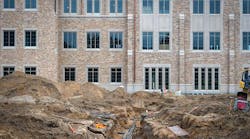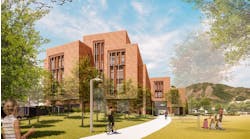As part of a comprehensive sustainability strategy, the University of Notre Dame in Notre Dame, Ind., has installed geothermal systems on its campus.
The university says the first phase of the project was completed last year on the East Quad of the campus.
In order to provide more efficient heating and cooling to the Ricci Band Building and Pasquerilla Center, the university has installed a 300-ton geothermal energy field in the grassy quad south of McCourtney Hall and east of Hesburgh Library. Consisting of 153 wells, the system provides Ricci and Pasquerilla Halls with 150 tons of capacity; that leaves 150 additional tons available for future development.
In the second phase a geothermal well field was installed beneath the parking lots south of Notre Dame Stadium. Consisting of approximately 500 wells and 1,000 tons of capacity, this field is considerably larger than the Ricci/Pasquerella field. Unlike the East Quad system which provides heating and cooling exclusively for specific buildings, the south campus system will be tied both to future buildings in the area and to the central campus chilled water system.
“Connecting our geothermal fields to both localized and centralized systems allows the University to maximize its energy efficiency,” says Paul Kempf, senior director of utilities and maintenance. “If more chilled water is produced than the local building needs, the excess can be put into the central system for use elsewhere on campus.”
The third phase consists of about 650 wells and 1,350 tons of capacity under what will become the new Ricci Athletic Fields on the north end of campus. This system will connect to a new remote chiller plant. Connecting this geothermal field to the plant will increase flexibility by enabling the field to serve both the central chilled water cooling system and a new regional east campus hot water heating system.
The South Bend Tribune reports that so far, only the geothermal field near the campus library—the smallest installation—is operating. The other two fields are expected to come online in 2018 and 2019.
When they are operational, these three systems together will have the capacity to reduce Notre Dame’s carbon dioxide emissions by 11,803 tons, an 8 percent reduction compared with fiscal year 2016 and the equivalent of taking almost 1,000 cars off the road each year.


